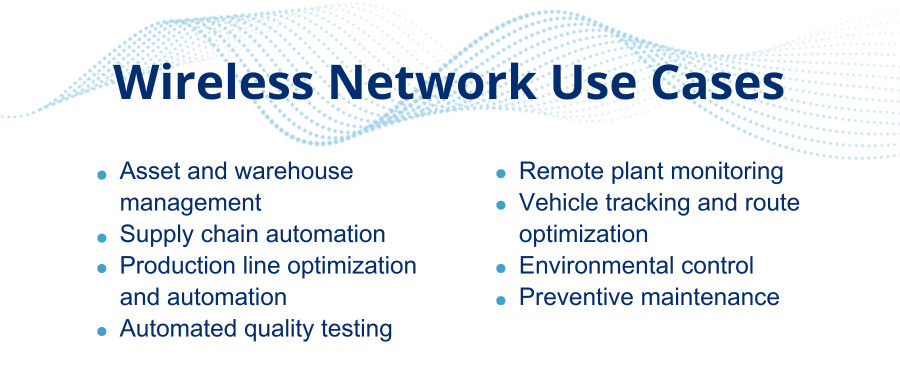Like most other sectors, the manufacturing industry has been rocked in recent years by the effects of unexpected global events. At the same time, new technology innovations promise to transform the way manufacturers do business.
To grasp these opportunities and increase resilience in an uncertain world, manufacturers are under pressure to connect complex processes, data flows, and supply chains. What are the challenges that the sector faces, how is wireless networking evolving, and how can it help manufacturers thrive in a volatile business environment?
The Changing Face of Manufacturing
The fourth industrial revolution promises to harness new technologies – such as the Internet of Things (IoT), automation, AI, and 5G – to create smart, connected manufacturing operations. This offers manufacturers huge opportunities to grow and evolve, but the sector also faces major challenges.
Manufacturing supply chains are becoming ever-more complex and interconnected, and often involve hundreds of thousands of components and assets in a variety of processes and locations worldwide. A car, for example, might be made up of 30,000 individual parts, many of which are manufactured by suppliers in different countries from the one the car is assembled in.
The explosive growth in data generation offers opportunities to make operations faster and more efficient, and to provide a better end-to-end experience for customers. This data comes from a wide variety of sources, such as IoT devices, product data, and customer insight.
Consumers are demanding a more streamlined customer experience, products that are more customizable and available faster, and greater transparency on the ethical and environmental impacts of the products they buy.
Visibility of data, processes, and assets is also critical for manufacturers seeking to increase resilience and agility, after the COVID pandemic and the war in Ukraine highlighted significant vulnerabilities for many companies. The reality is, however, that information often does not flow freely among locations, processes, and supply chains.
Wired Networks Struggle To Keep up With New Demands
Using cellular networks to provide wireless connectivity across local or wide area networks has traditionally been a last resort or backup option. This is changing, however, driven by the evolution of wireless networking, and the fact that wired networks no longer fully meet the changing needs of manufacturing.
The rising number of connected devices within smart factories and processes places huge demands on the network. With the number of connected devices in manufacturing forecast to rise from 81.7 million in 2020 to more than 200 million by 2030, this issue isn’t going away.
Another complicating factor is that assets in the supply chain are often moving between locations. Even when assets are static, manufacturing locations can be remote or geographically challenging – think of rare earth metal production in Mongolia, for example – making network connectivity within and between sites difficult and costly.
It can also be challenging to provide wired connectivity across large areas of operations, such as large chemical plants or ports, or to quickly connect temporary sites.
Wireless Networking Provides Greater Bandwidth and Reliability
The evolution of cellular networking has dramatically increased both bandwidth and the density of connections on each cell tower – it’s believed that 5G, for example, has the capacity to handle up to 100 times more connections per square kilometer than 4G.
At the same time, software-defined wide area networking (SD-WAN) has the ability to aggregate multiple connections to provide much greater bandwidth.
This makes today’s wireless much more suitable for coping with the rising capacity needs and exponential growth of connected devices in manufacturing. Options include public 4G LTE or 5G networks (which are cost-effective and easy to set up), or private versions (which are more costly, but offer additional network control, visibility, and security).

Greater Reliability and Faster Provisioning
Wireless networking also boosts reliability, avoiding the interruptions to operations and lost revenue that downtime entails.
Organizations using wireless WAN as the primary connectivity at most sites reported an average of 88% less downtime. Even as a backup option, it continues to offer greater reliability: Organizations using wireless WAN for failover at the majority of their sites experience a 62% reduction in downtime.
Wireless networking also offers faster provisioning, making manufacturers more agile, and boosting productivity.
Provisioning wireless connections is also significantly faster. Wired connections take an average of 35 days to come online, whereas 4G or 5G connections take around 26 minutes to set up. This makes wireless an effective option for temporary sites, as well as large or challenging locations.
Disparate Supply Chains Come Together With Wireless
With wireless networking, assets of all kinds (including raw materials, components, products , and vehicles) can be monitored and tracked into fully connected flows moving among many different processes and locations.
locations.
This capability provides unprecedented visibility of global supply chains in real time, helping to cut costs, improve collaboration with partners, and boost customer experience. Connecting assets, data, and locations removes organizational siloes and makes it easier to continually increase efficiency and make fast, informed business decisions.
Wireless networking also helps to enable greater resilience in the face of unexpected events – it’s much easier to work around challenges, after all, if you can see where all your assets are, and how they move around.
Wireless Enables Edge Computing
The promise of faster speeds and lower latency of 5G wireless networking also makes it suitable for edge computing.
Edge puts computer processing and storage capabilities closer to the places where data is produced, analyzed, and consumed, making it easier to harness and act on valuable data. For example, when edge computing is used to process diagnostic data from production lines, problems can be identified and tackled sooner, helping to reduce downtime.
Some wireless routers, such as Cradlepoint routers, even have light edge computing capabilities built into them.
How Globalgig Helps Binsentry Grow Internationally With Simple, Reliable Wireless Connectivity
The Challenge
BinSentry is an industry leader in feed ordering automation, providing end-to-end solutions with IoT sensors that collect feed bin-level data on the farm, and transmit this information to the cloud. As the company began to grow internationally, however, providing wireless connectivity across large areas in rural locations – with many different carriers, contracts, and bills – was complex, costly, and time-consuming.
The Solution
Globalgig’s solution provides a seamless, single source of wireless connectivity for BinSentry’s IoT devices across all global locations. Powered by a small solar panel, BinSentry’s devices use LTE-M technology with 2G fallback, providing reduced power usage and better transmission ranges, to provide more consistent coverage in rural markets.
The Benefits
The solution provides optimal coverage and pricing flexibility. With the Globalgig eSIM, BinSentry can now share data across LTE-M devices to optimize usage.
BinSentry has seen measurable benefits as a result, including streamlined feed inventory tracking and ordering, better ROI and operational efficiency, and greater ability to scale globally, with one network partner and simpler management.
“Globalgig’s wireless network solution is an enabler for BinSentry to go after global opportunities without the hassle of managing multiple carriers in every country,” says BinSentry CEO Randall Schwartzentruber.
Read more about BinSentry’s story.
Wireless Networking: The Foundation for Manufacturing’s Future
As the face of manufacturing evolves in the digital age, new generations of wireless networking provide the capacity and flexibility that manufacturers need to connect complex supply chains and processes into a coherent whole. By enabling smart manufacturing, wireless networking helps manufacturers to boost efficiency, increase agility and resilience, and improve supply chain transparency.
